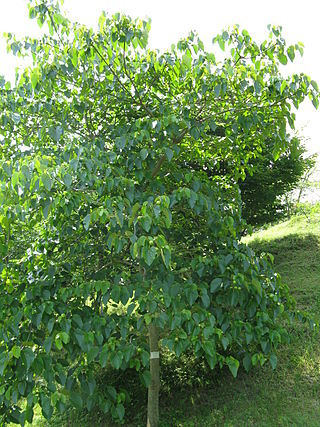
Vernicia fordii is a species of flowering plant in the spurge family Euphorbiaceae. It is native to southern China, Myanmar, and northern Vietnam. It is a small to medium-sized deciduous tree growing to 20 m tall, with a spreading crown. The bark is smooth and thin, and bleeds latex if cut. The leaves are alternate, simple, 4.5–25 cm long and 3.5–22 cm broad, heart-shaped or with three shallow, maple-like lobes, green above and below, red conspicuous glands at the base of the leaf, and with a 5.5–26 cm long petiole. The flowers are 2.5–3.5 cm diameter, with five pale pink to purple petals with streaks of darker red or purple in the throat; it is monoecious with individual flowers either male or female, but produced together in the inflorescences. The flowers appear before or with the leaves in loose, terminal clusters. The fruit is a hard, woody pear-shaped berry 4–6 cm long and 3–5 cm diameter, containing four or five large, oily seeds; it is green initially, becoming dull brown when ripe in autumn.

Rosa moyesii is a species of flowering plant in the rose family Rosaceae. It is native to western China. Growing to 4 m (13 ft) tall by 3 m (10 ft) wide, it is a vigorous deciduous shrub, with plentiful matte green leaves and flat red or pink flowers, with yellow central stamens, in summer. These are followed in autumn by prominent bottle-shaped rose-hips.
Ormosia hosiei is a species of flowering plant in the family Fabaceae.

Asarum maximum is a species of plant in the family Aristolochiaceae. It is endemic to China. The flowers have a distinct smell of mushrooms.
Phoebe bournei is a species of tree up to 20 metres (66 ft) tall in the family Lauraceae. It is endemic to China, where it occurs in Fujian, Guangdong, Guangxi, Guizhou, Hainan, Hubei, and Jiangxi provinces. It is threatened by habitat loss. The species is under second-class national protection in China.

Chaenomeles cathayensis is a species of flowering plant in the rose family, Rosaceae. It is native to China, Bhutan, and Myanmar. In Chinese, its common name is mùguā hǎitáng (木瓜海棠) or máo yè mùguā (毛葉木瓜).

Malus prattii is a species of crabapple in the family Rosaceae. It is endemic to China. It is indigenous to Guangdong, Guizhou, west Sichuan, and northwest Yunnan provinces in China.
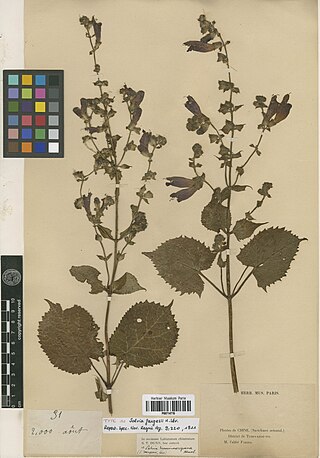
Salvia maximowicziana is a perennial plant in the family Lamiaceae. It is found growing on grasslands, forests, and forest edges in China, at 1,800 to 3,300 m elevation. It grows 10 to 90 cm tall, with circular-cordate to ovate-cordate leaves that are typically 3 to 8 cm long and 6 to 8 cm wide. The upper leaf surface is nearly smooth, or lightly covered with hairs, while the underside has glandular hairs on the veins.
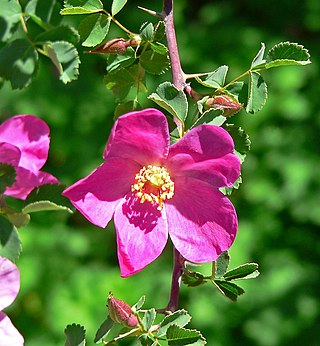
Rosa willmottiae, Miss Willmott's rose or Willmott's rose, is a species of flowering plant in the family Rosaceae. It grows at an altitude of 2,300–3,150 metres (7,550–10,330 ft) in dry valleys in western Sichuan, China. It forms an arching deciduous shrub 2–3 m high, and as much across. The branches are covered in many straight prickles. The pinnate leaves typically have 7 to 9 small bluish-green leaflets which emit a pleasant fragrance when bruised. It was introduced to western cultivation by Ernest Wilson in 1904 and was named after the collector and horticulturist Ellen Willmott. The flowers are small, lilac-pink, and are borne on short laterals all along the length of the branches in late spring/early summer. The hips are small, becoming orange-red and losing their tips when ripe.

Cornus controversa, syn. Swida controversa, is a species of flowering plant in the dogwood family Cornaceae. It is native to China, Korea, the Himalayas and Japan. It is a deciduous tree growing to 50 ft (15 m), with multiple tiered branches. Flat panicles of white flowers appear in summer, followed by globose black fruit. Ovate dark green leaves are glaucous underneath and turn red-purple in autumn. It is cultivated in gardens and parks in temperate regions.

Rhododendron hancockii (滇南杜鹃) is a species of flowering plant in the family Ericaceae. It is. native to Guangxi and Yunnan, China, where it grows at altitudes of 1,100–2,000 m (3,600–6,600 ft). It is a shrub or tree that grows to 2–7 m (6.6–23.0 ft) in height, with leathery leaves that are obovate or oblong-oblanceolate, 7–13 by 1.5–5 cm in size. The flowers are white with yellowish flecks.

Rhododendron concinnum (秀雅杜鹃) is a species of flowering plant in the family Ericaceae. It is native to Guizhou, Henan, Hubei, Shaanxi, Sichuan, and Yunnan in China, where it grows at altitudes of 2300–3000 meters. It is a shrub that grows to 1.5–3 m in height, with leaves that are oblong, elliptic, ovate, oblong-lanceolate or ovate-lanceolate, 2.5–7.5 by 1.5–3.5 cm in size. Flowers are pale pink to deep purplish red.
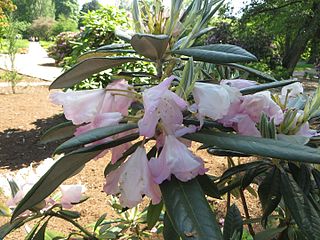
Rhododendron insigne (不凡杜鹃) is a species of flowering plant in the family Ericaceae. It is native to southern Sichuan in China, where it grows at altitudes of 700–2,000 m (2,300–6,600 ft). This evergreen shrub grows to 1.5–6 m (4.9–19.7 ft) in height, with leathery leaves that are obovate-elliptic, obovate-lanceolate, oblong, or oblong-lanceolate, 8–13 by 2.5–4.5 cm in size. The flowers are pale to dark pink.
Mazus gracilis is a species of flowering plant in the family Mazaceae. It is native to the Provinces of Henan, Hubei, Jiangsu, Jiangxi and Zhejiang in China. It grows on lake shores, river banks, and other moist areas at elevations below 800 m.
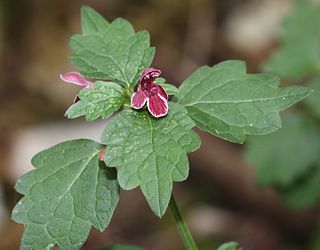
Loxocalyx is a genus of plants in the family Lamiaceae, first described in 1891. It is native to China and Japan.
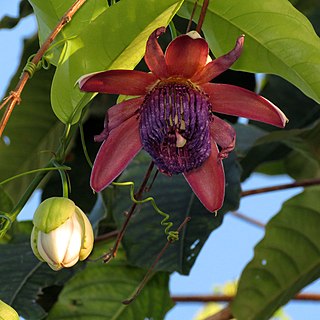
Passiflora ambigua is a species of flowering plant in the family Passifloraceae . It is found in Mexico, Belize, Costa Rica, and Colombia.
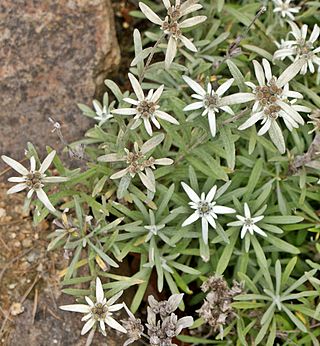
Leontopodium sinense is a species of plant in the family Asteraceae. It is native to China.
Ainsliaea elegans is a species of flowering plants in the family Asteraceae. It is found in China and Vietnam.

Fraxinus malacophylla is a species of ash tree in the family Oleaceae. It is native to China, where it is found in Guangxi and Yunnan provinces, and Thailand.















